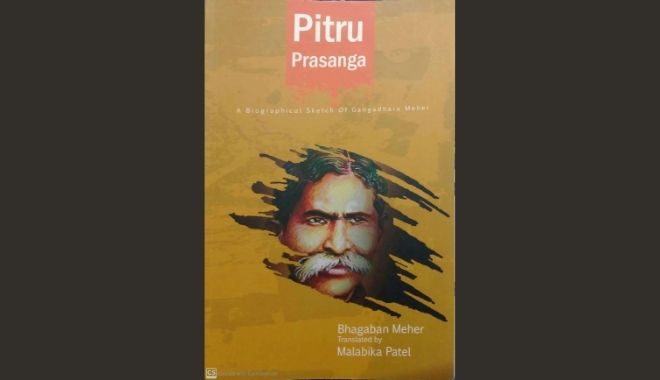A Tribute Patremoir
Pitru Prasanga: A Biographical Sketch of Gangadhar Meher By Bhagaban Meher. Translated by Malabika Patel—Bhubaneswar: Odia Sahitya Anubad Parishad, 2020. Pp.102. Price: Rs. 200

Odia life writing had the most remarkable and innovative debut in 1927 with the posthumous publication of Phakirmohan Senapati’s autobiography entitled Atmacharita. Since then, scores of auto/biographies, memoirs, personal essays, diaries and letters have been added to the Odia literary corpus and life narratives have emerged as one of the major contributors to the socio-historical memory archive of Odisha.
The range of meditations on the self in relation with art, society, desire, disease, death, and politics, in Odia life narratives is marked by a peculiar orientation toward the community. They thus differ from their Western counterparts with their often narcissistic and obsessive portrayal of the self. The book under review is a case in point. It offers an intimate portrayal of the life and times of Odisha’s ‘SwabhabaKabi’ Gangadhar Meher, the author of many poetical masterpieces, including the magnum opus ‘Tapaswini’. Written by Gangadhar Meher’s youngest son, Bhagaban Meher, it was originally published in 1977. The English translation of the book done by Malabika Patel has been recently published by Anubad Parishad, a Forum for Translation in Odisha set up in 2019. The first offering of the Forum in the category of Odia-to-English Anuvad, the translation retains the original Odia title with the subtitle “A Biographical Sketch of Gangadhara Meher”.
Pitru Prasanga, like Pitrusmriti, an account of the life of Radhanath Ray written by his son Sashibhusan Ray, belongs to a specific category of life writing called ‘Father Memoir’ or, to use a phrase by Richard Freadman, “a son’s book of the father.” Father memoirs are in general as much about the son as they are about the father and it is precisely through the writing of his father that the son forms his own identity. Pitru Prasanga, however, appears to be an exception to this rule.
Here the son, though a co-witness to the life and times of his poet-father, is rarely ever the co-protagonist of the book. In the Prologue to the English translation of the book, Manindra Meher, grandson of Bhagaban Meher, writes that his grandfather “was not only a son but a close friend and confidante in his father’s journey as a poet. Whatever the poet used to scribble in scraps of paper or on a slate, Bhagaban used to copy it down . . . He used to study the poet’s writing with care. . . On many a request from fellow beings he was awakened to his sense of duty and undertook the task of writing ‘Pitru Prasanga.’” Needless to say, the son recedes to the background, allowing the spotlight to be unremittingly on the father. Thus, what emerges is a kind and compassionate portrait of one of the greatest poets of Odisha.
One of the major achievements of Pitru Prasanga is the calmness of the narrative voice (sensitively rendered by the translator) that permeates the book from stem to stern. It opens with a vivid resurrection of the socio-economic and historical ambience of Barapalli (present-day Bargarh and the birthplace of Gangadhar Meher) in Sambalpur and its surrounding neighbourhoods. As the narrative navigates from landscape to life, the reader encounters the making of an artist, committed from early on, to a life in literature. Born into a weaver’s family in 1862, Gangadhar Meher was educated up to Class V. But he had a tremendous flair for Sanskrit—a tool with which he would re-imagine the Odia language. Even as he supported his family through weaving and later by working as a Mal Moharir, Meher lived a life perpetually torn between his sense of duty as a family man and his literary calling.
Another highlight of the book is the vivid glimpse it gives of the coming together of the crème de la crème of the late 19th century Odia litterateurs, at times in person and at other times through letters. Gangadhar Meher’s meetings and exchanges with literary doyens like Kabibar Radhanath Ray, Vyas Kabi Phakirmohan Senapati, Palli Kabi Nandakishore Bal and others not only provide an authentic record of the literary-cultural scene that these poets helped create but also illuminate the deep respect and friendship that they shared. As verses were exchanged and pondered, as books were sent and recommended, the letters proved to be an essential vehicle of Meher’s work. Particularly inspiring is his correspondence with Radhanath Ray, which shows how each of them provided a steadfast reference point for the other in times good and bad. His meeting with Phakirmohan Senapati, first at the Utkal Sammilani, held in December 1915 at Sambalpur, and then a year later in Balasore, where Meher stayed at Senapati’s house (which he likened to a “hermit’s ashram”) speaks volumes of a life-sustaining literary friendship.
The portrait of Gangadhar Meher which emerges from the gentle exploration of his life and times by his son is that of a kind, tender-hearted man whose art becomes an extension of his humane self. The memoir also shows the tensions that play out between the self and the community. As Gangadhar Meher’s reformist bent of mind suffers the worst assaults in the wake of the caste violence that breaks out in Barapalli, one cannot help but notice the inherent irony of the situation. If Meher’s moral integrity and compassion led to his suffering, then surprisingly it is those very qualities which make the assaults bearable. Lying on the death bed, the poet sums up his own life in these words: “In this world, I was like a medicinal plant, now it is God’s wish” (88).
Pitru Prasanga is a tribute patremoir that conveys a son’s profound love and respect for his gifted father while it shines a light on his time and clime.

Comments are closed.